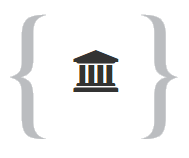Σύμφωνα με την παράδοση, η Νέα Μονή ιδρύθηκε από τον αυτοκράτορα Κωνσταντίνο Θ' Μονομάχο (1042-1055) για να ανταμείψει δύο μοναχούς από τη Χίο, οι οποίοι του είχαν προφητεύσει όταν ήταν εξόριστος στη Μυτιλήνη ότι η εξορία του θα τελείωνε σύντομα και ότι θα ανέβαινε στο θρόνο.
Το μοναστήρι χτίστηκε περίπου στη μέση του νησιού στη δυτική πλευρά του όρους Προβάτειο, όπου λίγα χρόνια νωρίτερα οι μοναχοί είχαν βρει τη θαυματουργή εικόνα της Παναγίας κρεμασμένη από κλαδί μυρτιάς.
Ο Μονομάχος προίκισε το μοναστήρι με γη και δικά του έσοδα, τακτική που ακολούθησαν άλλοι αυτοκράτορες, με αποτέλεσμα η Νέα Μονή να γίνει ένα από τα πιο γνωστά και πλουσιότερα μοναστήρια του Αιγαίου μέχρι την εποχή της Ελληνικής Επανάστασης (1821-1830). ) όταν εισήλθε σε οικονομική παρακμή. Κατά τη διάρκεια των εννιακόσια χρόνων ζωής του, το μοναστήρι έχει δοκιμαστεί σκληρά σε πολλές περιπτώσεις από την καταστροφική τρέλα των ανθρώπων και τα φυσικά στοιχεία. Υπέστη τις χειρότερες καταστροφές του τον 19ο αιώνα, όταν το μοναστήρι λεηλατήθηκε και πυρπολήθηκε από τους Τούρκους το 1822, και ο κύριος τρούλος του Καθολικού και μέρος του ιερού κατέρρευσαν κατά τον καταστροφικό σεισμό του 1881. Τα σωζόμενα τμήματα του αρχικό μοναστηριακό συγκρότημα είναι το Καθολικό, η στέρνα, το κάτω μέρος του αμυντικού πύργου και ο ανατολικός τοίχος με την αψίδα στην τραπεζαρία του μοναχού.
Το Καθολικό της Νέας Μονής είναι ένας νησιωτικός οκτάγωνος ναός και πιθανότατα χρησίμευσε ως πρότυπο για τον τύπο. Είναι ένα από τα ωραιότερα μνημεία της βυζαντινής τέχνης, λόγω τόσο της αρχιτεκτονικής του όσο και των ψηφιδωτών με τα οποία είναι στολισμένο, τα οποία αποτελούν εξαιρετικά έργα τέχνης Κωνσταντινουπολιτών τεχνιτών του 11ου αιώνα.
(EL)
According to tradition, Nea Moni was founded by the emperor Constantine IX Monomachos (1042-1055) in order to reward two monks from Chios, who had prophesied to him when he was in exile on Mitilini that his exile would soon come to an end and that he would ascend the throne.
The monastery was built in roughly the middle of the island on the west side of Mount Provateion, where a few years earlier the monks had found the miraculous icon of the Virgin hanging from a myrtle branch.
Monomachos endowed the monastery with land and its own income, a tactic followed by other emperors, with the result that Nea Moni became one of the most famous and wealthiest monasteries in the Aegean down to the time of the Greek War of Independence (1821-1830) when it entered upon economic decline. During its nine hundred years of life, the monastery has been sorely tried on many occasions by the destructive madness of men and the natural elements. It suffered its worst devastation in the 19th century when the monastery was looted and put to the torch by the Turks in 1822, and the main dome of the Katholikon and part of the sanctuary collapsed during the devastating earthquake of 1881. The surviving parts of the original monastery complex are the Katholikon, the cistern, the lower part of the defence tower, and the east wall with the apse in the monk's refectory.
The Katholikon of Nea Moni is an insular domed octagon church and probably served as the model for the type. It is one of the finest monuments of Byzantine art, on account both of its architecture and of the mosaics with which it is adorned, which are outstanding works of art by 11th-century Constantinopolitan craftsmen.
(EN)
 Institute of Computer Science - Foundation for Research and Technology Hellas.
Institute of Computer Science - Foundation for Research and Technology Hellas.



 City / village / populated place
City / village / populated place
